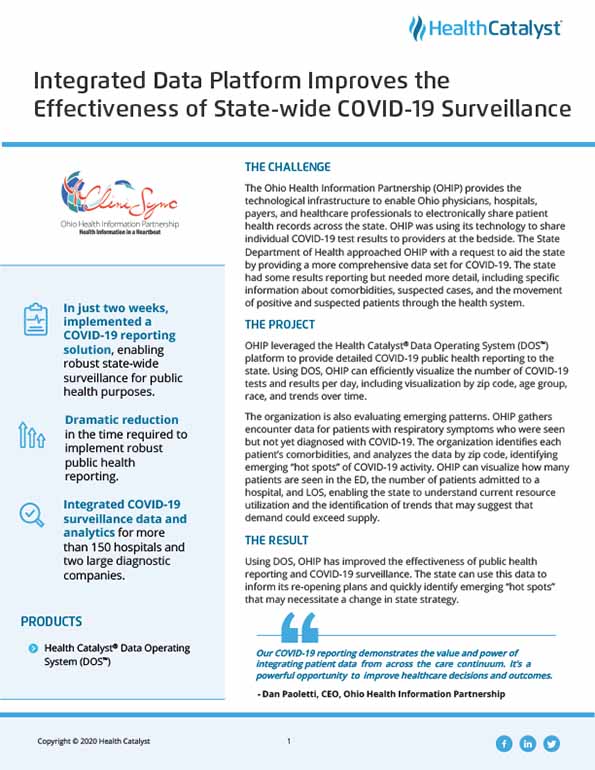The Ohio Health Information Partnership (OHIP) was using its technology to share individual COVID-19 test results to providers at the bedside. The State Department of Health approached OHIP with a request to aid the state by providing a more comprehensive data set for COVID-19. Using the Health Catalyst® Data Operating System (DOS™) platform, OHIP has improved the effectiveness of public health reporting and COVID-19 surveillance.
The Ohio Health Information Partnership (OHIP) provides the technological infrastructure to enable Ohio physicians, hospitals, payers, and healthcare professionals to electronically share patient health records across the state. OHIP was using its technology to share individual COVID-19 test results to providers at the bedside. The State Department of Health approached OHIP with a request to aid the state by providing a more comprehensive data set for COVID-19. The state had some results reporting but needed more detail, including specific information about comorbidities, suspected cases, and the movement of positive and suspected patients through the health system.
OHIP leveraged the Health Catalyst® Data Operating System (DOS™) platform to provide detailed COVID-19 public health reporting to the state. Using DOS, OHIP can efficiently visualize the number of COVID-19 tests and results per day, including visualization by zip code, age group, race, and trends over time.
The organization is also evaluating emerging patterns. OHIP gathers encounter data for patients with respiratory symptoms who were seen but not yet diagnosed with COVID-19. The organization identifies each patient’s comorbidities, and analyzes the data by zip code, identifying emerging “hot spots” of COVID-19 activity. OHIP can visualize how many patients are seen in the ED, the number of patients admitted to a hospital, and LOS, enabling the state to understand current resource utilization and the identification of trends that may suggest that demand could exceed supply.
Using DOS, OHIP has improved the effectiveness of public health reporting and COVID-19 surveillance. The state can use this data to inform its re-opening plans and quickly identify emerging “hot spots” that may necessitate a change in state strategy.
“Our COVID-19 reporting demonstrates the value and power of integrating patient data from across the care continuum. It’s a powerful opportunity to improve healthcare decisions and outcomes.”
– Dan Paoletti, CEO, Ohio Health Information Partnership




